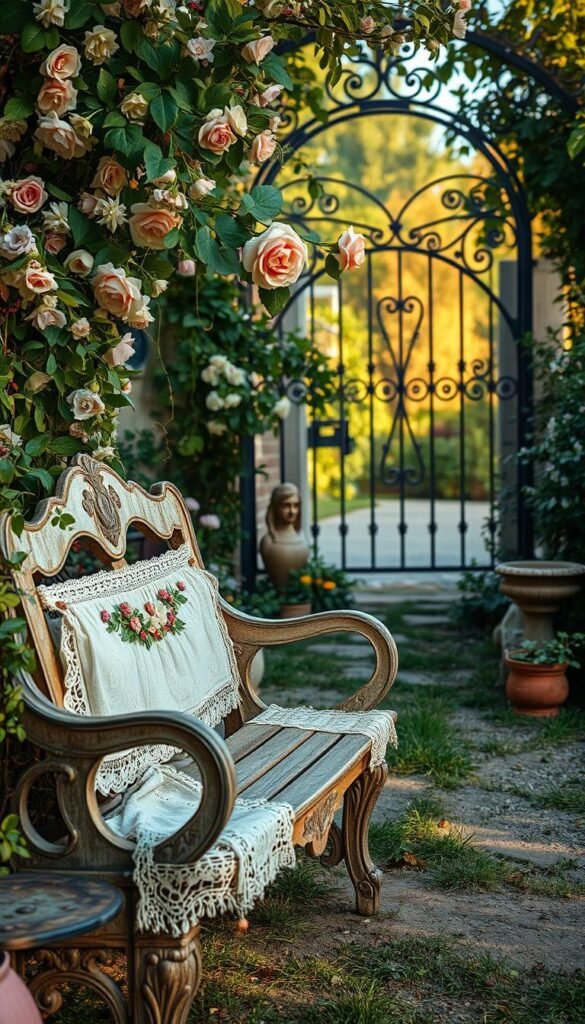There’s something magical about giving old pieces a second chance. Whether it’s a weathered bench or a forgotten planter, repurposing vintage finds adds character to your outdoor space. Each piece tells a story, blending history with nature in a way that feels uniquely yours.
Like the folks at Comfy Lane Cottage, you might find joy in restoring broken items. It’s not just about saving money—it’s about creating a space that reflects your personality. These treasures often work both indoors and out, offering flexibility in your decor.
In this guide, you’ll discover how to hunt for hidden gems at local thrift spots. We’ll also share simple restoration tricks and styling ideas to make your space shine.
Where to Hunt for Shabby Chic Garden Treasures
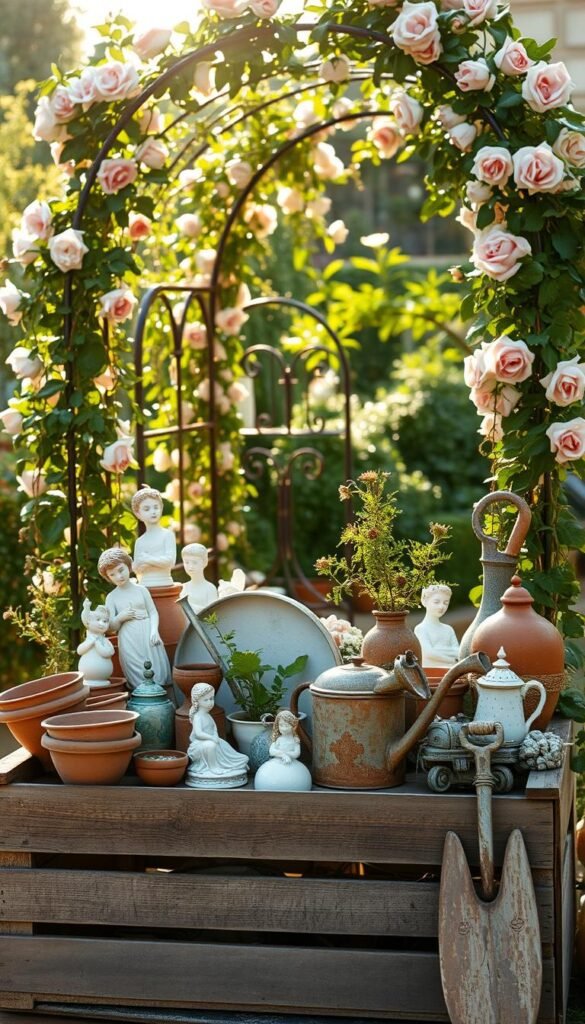
The thrill of uncovering forgotten relics turns every hunt into an adventure. From dusty barns to digital listings, hidden gems await those who know where to look. Here’s your roadmap to the best spots for vintage finds.
Flea Markets and Estate Sales: Hidden Gems Await
Estate sales often yield rare pieces with rich histories. Arrive early for the best picks, and don’t shy away from haggling. A set of 1920s apple crates, for example, can become charming tiered planters.
Pro tip: “Never pay more than $10 for spreaders,” advises a seasoned thrifter. Seasonal cleanups also offer “curb to cottage” opportunities—keep an eye out during spring.
Thrift Stores and Garage Sales: Budget-Friendly Options
Garage sales are goldmines for affordable steals. Stores like ReStore often discount items like rusted toolboxes, perfect for upcycling. Check discount sections for overlooked treasures.
For repurposing wooden crates, local thrift spots are ideal. Pair them with barrels for a cohesive rustic look.
Online Marketplaces: Expand Your Search Radius
Facebook Marketplace alerts for “vintage garden” keywords can lead to rare finds, like a 1911 Thermos. Online auctions widen your reach—just verify dimensions before buying.
Caution: Avoid overpaying at barn sales. A $100 wheelbarrow might not be worth the splurge.
| Source | Pros | Cons |
|---|---|---|
| Estate Sales | Unique, high-quality items | Competitive; early birds win |
| Garage Sales | Low prices; negotiable | Hit-or-miss selection |
| Online Marketplaces | Wide variety; convenient | Shipping costs; no instant inspection |
Assessing Your Flea Market Finds Like a Pro
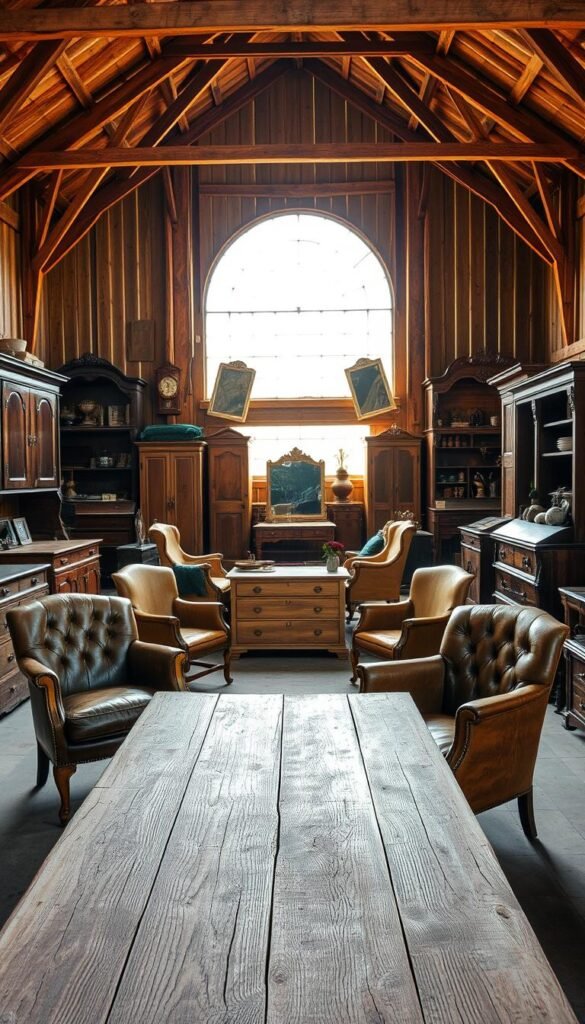
Every great restoration starts with a keen eye for potential. Whether it’s a weathered bench or a chipped planter, spotting hidden value saves time and money. Here’s how to evaluate items like an expert.
Spotting Quality Beneath the Rust and Dust
Rust isn’t always a dealbreaker. Test metal surfaces with vegetable oil—if it wipes clean, the piece is salvageable. For wood, check for rot by pressing a screwdriver into hidden spots. Solid frames last decades, even with scratches.
Rachel Ashwell’s golden rule: “Original chippy paint adds character.” Preserve it if the layers tell a story. Peeling veneer? Strip it to reveal raw wood for a fresh start.
Structural Integrity: What to Fix vs. What to Leave
Wobbly legs? Carpenter’s glue reinforces joints without altering aesthetics. Use flea market finds outdoors only if they withstand weather. Unstable planters? Prop them with milk cans for instant stability.
Walk away if:
- Termite damage spreads beyond small patches
- Wrought metal tables have deep cracks
- Repairs cost more than a replacement
Pricing Haggling Tips for Vintage Furniture
Love a piece but notice flaws? Say: “I’d adore this at $X—it needs new hinges.” Sellers often discount for specific repairs. For rare items, research comparable prices online first.
Zing Patio’s tip: Bundle multiple pieces for a better deal. A $50 chair might drop to $35 if paired with a side table.
Restoring Shabby Chic Furniture with Character
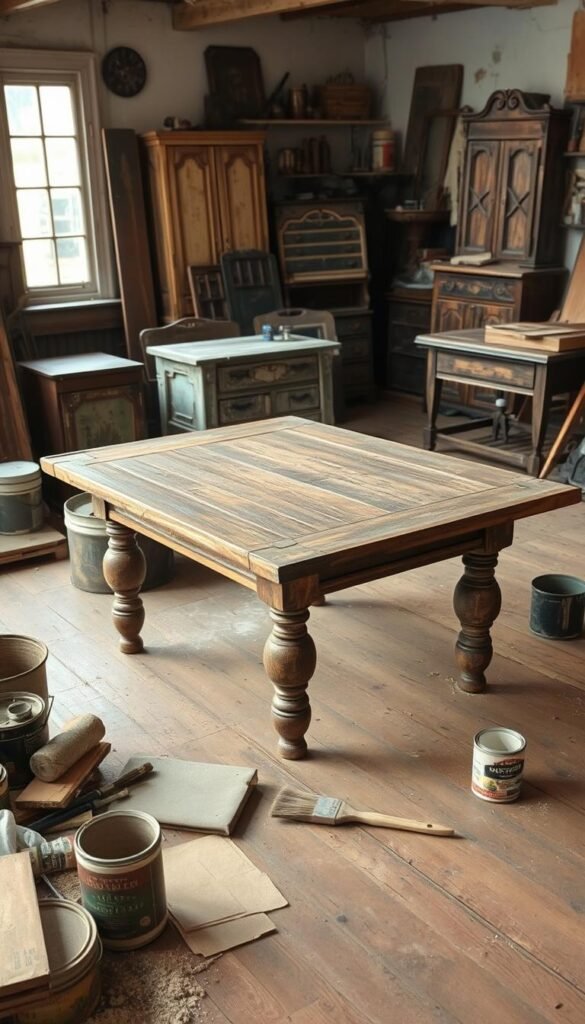
Breathing new life into worn pieces is an art form that blends creativity with patience. Whether you’re reviving a flea market chair or a weathered table, the right techniques preserve history while adding your personal touch. Here’s how to tackle common challenges with confidence.
Cleaning Secrets: Baking Soda, Lemon, and More
Start with Rachel Ashwell’s go-to mix: 1 tbsp baking soda + soapy water. This gentle solution lifts grime without damaging delicate surfaces. For copper accents, rub a lemon wedge dipped in salt—it polishes while adding a subtle shine.
Sticker residue? Peanut butter’s oils break it down effortlessly. Let it sit for 10 minutes, then wipe clean with warm water. For porcelain chips, nail polish in matching hues blends flaws seamlessly.
Chippy Paint or Fresh Coat? Choosing Your Finish
Original peeling layers tell a story—leave them if they add charm. For a cohesive look, Comfy Lane Cottage’s Wildflower Blue spray paint transformed a rusty bike into a garden standout.
Compare finishes:
| Type | Best For | Durability |
|---|---|---|
| Chalk Paint | Vintage texture; no sanding needed | Requires sealing |
| Milk Paint | Authentic matte finish | Naturally chip-resistant |
Rust Removal and Wood Repair Techniques
Vegetable oil dissolves light rust—apply with steel wool, then rinse. For stubborn spots, white vinegar soaks overnight. Sand wood gently to preserve grain, then condition with linseed oil.
Wobbly joints? Carpenter’s glue strengthens without visible fixes. “Embrace imperfections,” advises Comfy Lane. A hairline crack in a planter? Fill it with moss for whimsy.
Creative Ways to Style Your Restored Pieces
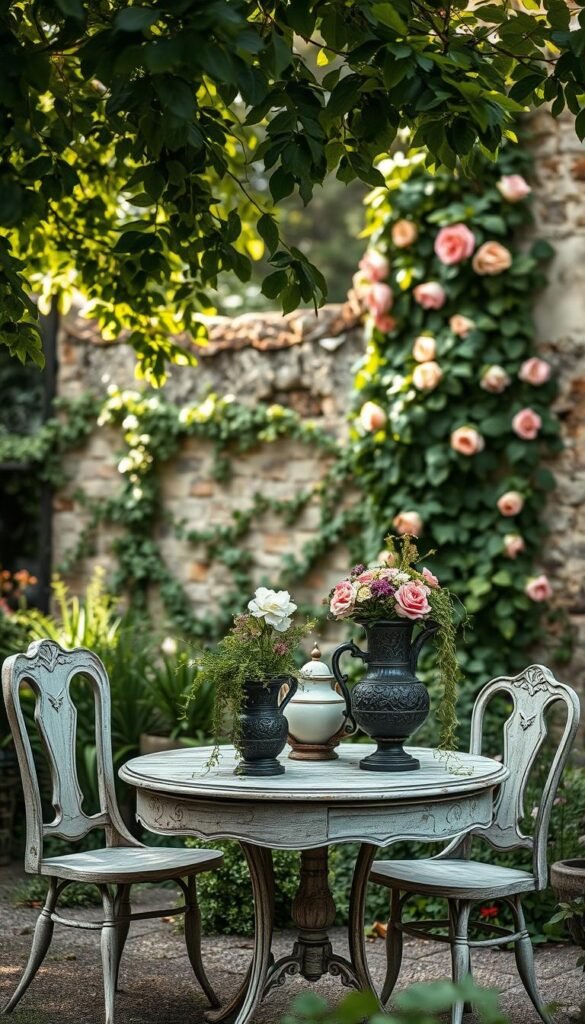
Transforming forgotten objects into garden treasures is where creativity blooms. Whether it’s a rusty wagon or a chipped milk can, the right styling turns functional pieces into focal points. Let’s explore how to showcase your finds with personality.
Wheelbarrows and Wagons as Whimsical Planters
An old wheelbarrow becomes a mobile flower bed with a few tweaks. Line it with burlap to retain soil, then add bricks to stabilize pots inside. Comfy Lane’s #wagondecortour proves even a cracked base can host a burst of flowers or herbs.
For seasonal flair, swap summer blooms for winter pinecones or pumpkins. Zing Patio suggests angling wagons near pathways to guide visitors through your garden story.
Milk Cans and Toolboxes: Unexpected Vases
Turn a dented milk can into a rustic vase by filling it with grocery-store bouquets. Pair it with upcycled household items like olive oil tins for a cohesive look. Toolboxes? Stack them sideways to hold trailing lavender or succulents.
Pro tip: Drill drainage holes in metal containers to prevent waterlogging. A Valentine’s Day display? Line a toolbox with moss and tuck in sprigs of eucalyptus.
Lighting Fixtures Repurposed as Garden Art
Chandeliers aren’t just for ceilings—remove wiring, hang them from tree branches, and insert floral water tubes for dangling blooms. A crystal piece catches sunlight, scattering rainbows across your patio.
For a subtler touch, nestle candleholders among ferns or use vintage bulbs as terrariums. “Lighting adds drama to forgotten corners,” notes a Zing Patio designer. Even a lone lampshade can shelter a bird’s nest or ivy vine.
Let Your Garden Tell a Story with Shabby Chic Charm
Your outdoor space can become a living scrapbook of memories. That rusted tool caddy from your husband’s shed? Fill it with flowers for a touch of nostalgia. A childhood wagon? Turn it into a “memory lane” planter for herbs.
Comfy Lane’s “beauty in the broken” philosophy shines here. Chipped paint or wobbly legs add character. Balance function with sentiment—use vintage chairs for seating, not just decor.
Zing Patio shows how historical pieces spark conversations. Share your restoration stories online to inspire others. After all, your home reflects the time and love you invest.

